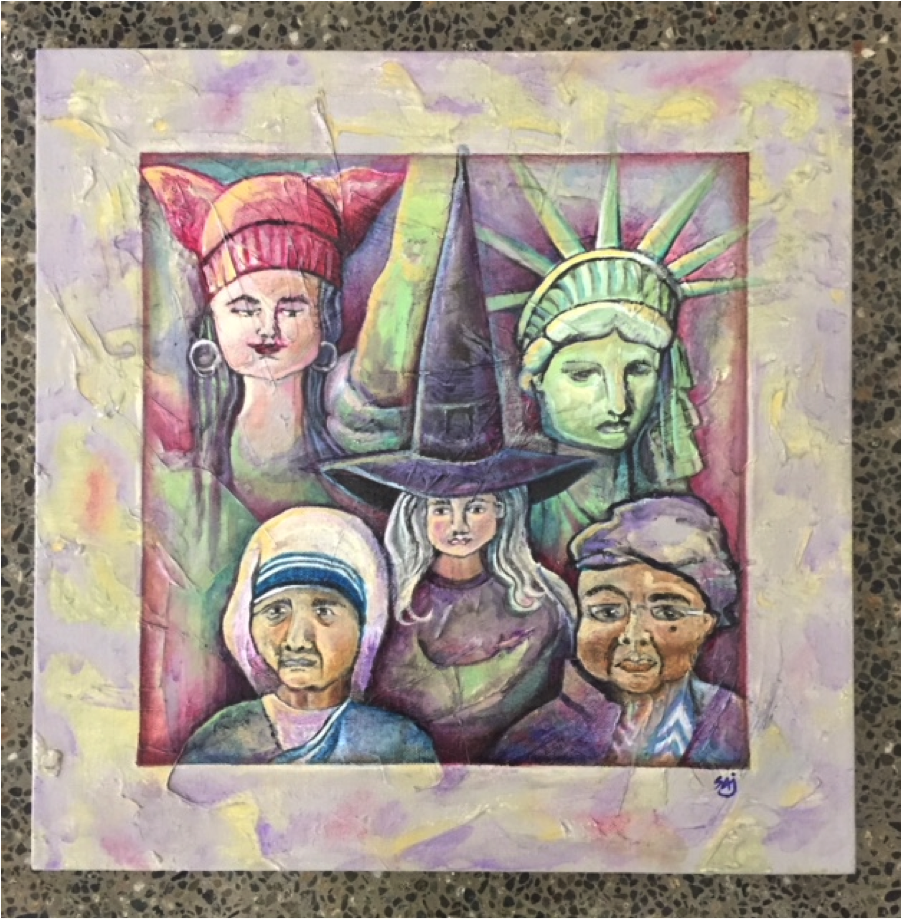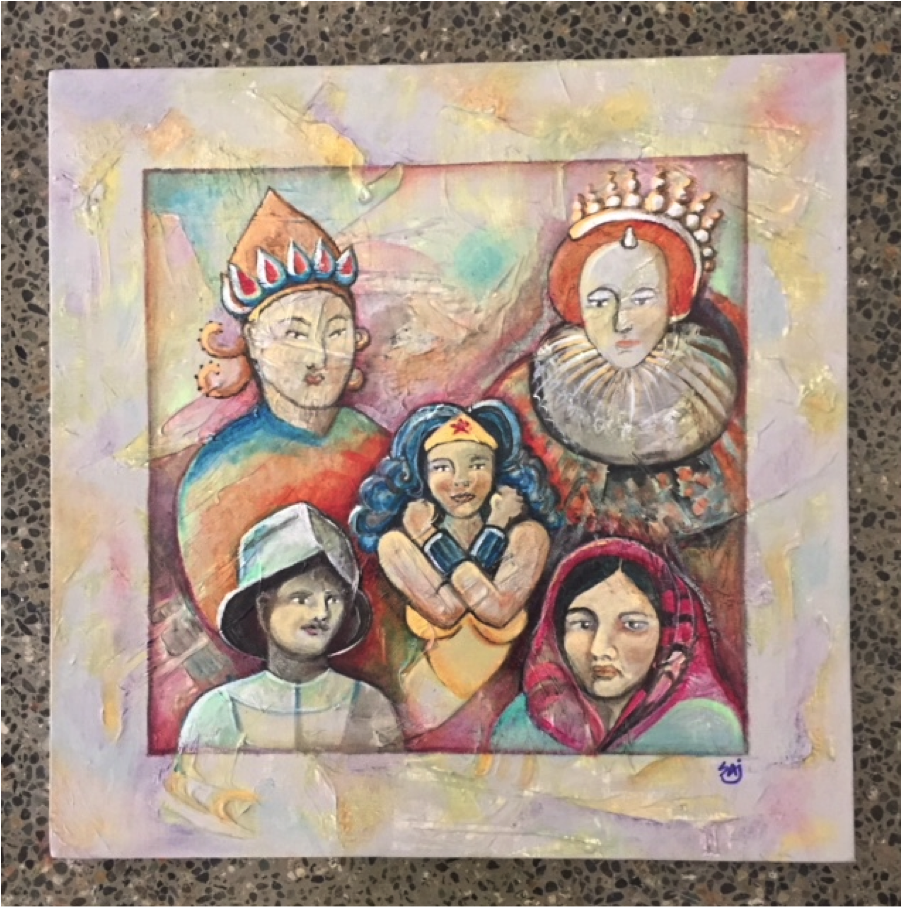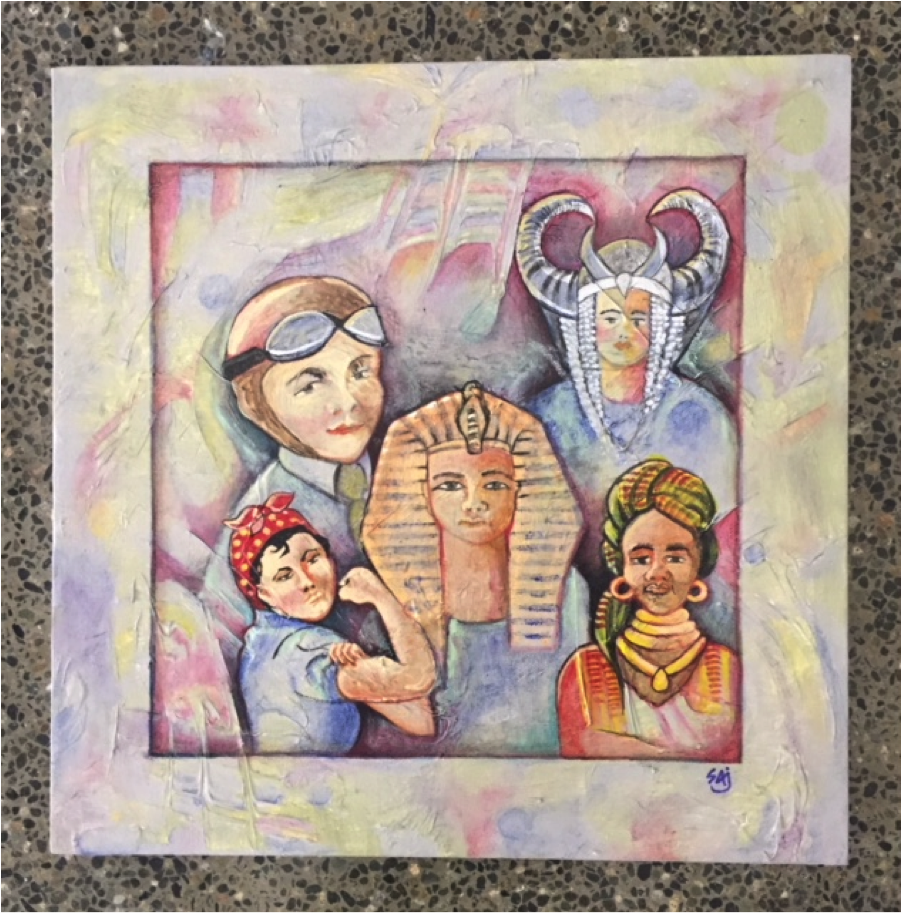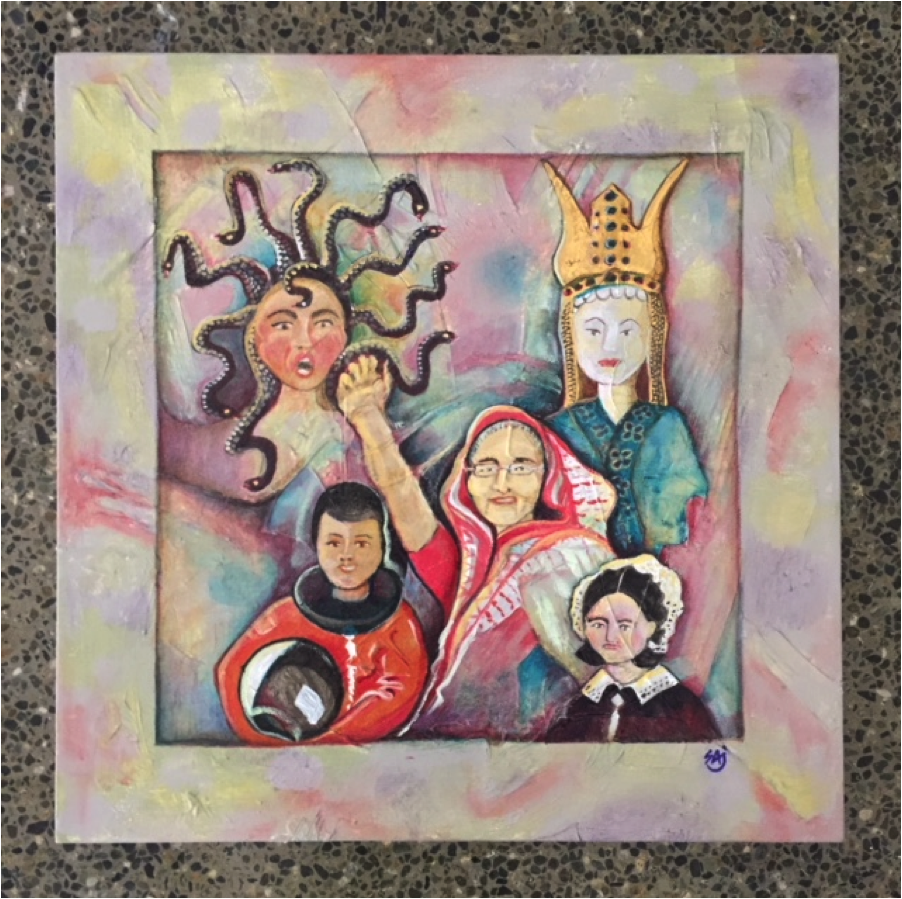I am so happy when art communicates an idea, and reaches its intended audience. We had such great feedback for our art show, “Disobedient Women”, and, due to public demand, it is being held over for another month! Check it out, at the Legacy Art Gallery, at the University of Victoria, now running till Sunday, January 21, 2018.
This show is brave, outspoken and celebratory. Thanks to Darlene Clover and team, a group of Vancouver Island artists came together to make art – visual, spoken, drummed, danced, etc – about the way women create change – through disobeying that which no longer serves us. Disobedience is sometimes the only way – for any marginalized person – to subvert out-dated power structures that limit our potential.
I was delighted to be commissioned to produce some paintings for this show. So in response to the inspiring women’s marches this summer, that reflected how women feel about power abuse, my series of four acrylic paintings, called ‘Essential headgear for Disobedient Women’, celebrates women everywhere who have changed the status quo or their circumstances by resisting that which has been ‘normalized’ for the benefit of a few. For any one feeling marginalized, breaking rules and resisting narratives that keep us small and powerless is essential. It takes courage, but together we create change, by speaking out and disobeying the old, limiting, thought-structures. We evolve culture and take up our power by creating new paradigms, whether in our homes, communities, or in the halls of office.
For this series, I selected 20 women across history and geography, both real and mythic, who represent the struggle all women have had with ceilings that keep us in our place. The choice of ‘who’ to represent was hard, and was only limited by time, space and materials. Brave game-changers exist everywhere, in the most rural and quiet places, and so no culture was intended to be excluded from this playful line up of disobedient women wearing their hats ‘of office’.
This series is a light, ironic, cartoonlike guide to female leadership – women who broke through glass ceilings, by using their heads. I have noticed that hats can sometimes represent power and status for men, and more often than not, veiling and glamour for women. How we apparel our heads, with crowns, helmets, or headscarves, can sometimes define our role, our values, our power, the communities to which we belong, the people we serve, or lead. So I deconstructed this ‘fashion’ statement, into a more ‘political’ statement. Taking up our full potential can sometimes mean putting on a hat reserved for the few, or sometimes taking off a hat as an act of rebellion. So “Hats off, girls!” – or “Hats ON!” – whatever is needed, as we continue to butt heads with all limiting ideas of who we can become, and which role we can play in society. We choose our own rules, our own hats, and our own potential.

1: The Pink Pussy – a grassroots, hand knitted, contemporary hat, worn during recent peaceful, womens’ marches across North America, when women’s voices were clearly heard.
The Liberty – a French-American hat, representing all women’s freedom and independence everywhere, as we transition psychologically from the old world into a new one.
The Witch – hats worn by mystical and medicinal devinators, representing the genocide of approximately 60 000 European women, who, at the instigation of the church, were hunted, tortured and burned for their knowledge.
The Teresa – Anjezë Gonxhe Bojaxhiu of Kosovo, also known as Mother Teresa, whose inner strength allowed her to tirelessly serve the marginalized of Calcutta.
The Ellen – Ellen Johnson Sirleaf of Liberia, Nobel Prize winner for womens’ rights and safety, and the first democratically elected female president in Africa.

2: The Wu – Wu Zetian, the only Empress Regnant to have ruled China, who expanded her empire, encouraged freedom of religion, and promoted women to power.
The Elizabeth Regina – Elizabeth, Queen of England and Ireland, who created a ‘Golden age’ by promoting trade, religious tolerance and the arts.
The Wonder Woman – a fictional superhero and founding member of the Justice League, demigoddess and Ambassador-at-Large of the Amazonian people.
The Joan – Jeanne d’Arc, a French shepherdess and wool spinner from Orleans, who was inspired to become a military leader, but who was burned at the stake for usurping a male role, and ‘cross dressing’ as a soldier.
The Malala – Malala Yousafzai, a young Pakistani activist, fighting for equal education for girls, and the youngest-ever Nobel Prize laureate, whom the Taliban unsuccessfully tried to murder, for her powerful advocacy for equality.

3: The Amelia – Amelia Earhart, an aviation pioneer and author, who was the first female to fly solo across the Atlantic Ocean.
The Shield Maiden – Hats worn by Norse women who abandoned the traditional gender pressures to stay-at-home, to become warriors, seafarers and explorers.
The Hatsepshut – headgear worn by the first recorded ‘great’ woman in history – one of the very few Egyptian female pharaohs, who financed her prolific building projects through establishing trade routes, and creating a peaceful reign.
The Rivetting Rosie – a war-time female icon, encouraging women to step into mens’ jobs, and whose slogan was “We can do it”.
The Amina – a fierce, Hausa, Muslim, Warrior-Queen from Nigeria who, like her contemporary, Elizabeth the First of England, chose the single life in order to maintain her authority and independence.

4: The Medusa – a beautiful, mythological Greek woman who was raped by Poseidon. Enraged, Athena protected her, by turning her curly hair into snakes, and gave Medusa the power to turn men to stone with her gaze. Perseus responded to Medusa’s new found power by beheading her.
The Seondeock – the Queen Regnant of Silla, Korea – the second female sovereign in recorded East Asian history, who encouraged a renaissance in thought, literature, and the arts.
The Hasina – Hasina Wajed, Prime Minister of Bangladesh, who broke the rules by being elected three times in a row. She is a member of the Council of Women World Leaders.
The Mae – Mae Jemison, an engineer, physician and NASA astronaut who became the first African-American woman to travel in space.
The Florence – Florence Nightingale, a prodigious writer, carer, and social reformer, who pioneered new nursing techniques during the Crimean war.
Come out and enjoy the other fun and inspiring exhibits at the ‘Disobedient women Exhibition’/